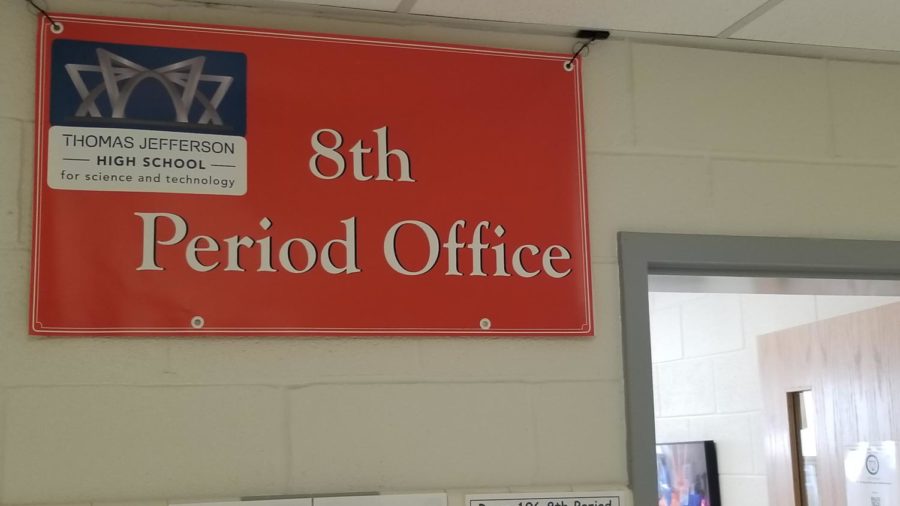Starting a club, demystified
Ms. Laura Slonina, who runs the 8th Period Office, says that the best way to learn about the club application process is to visit them in person, “Students are a little afraid to come in to the 8th Period Office and talk to me, but I’m more than willing to answer any questions.”
November 10, 2021
Starting a club at Jefferson seems simple enough: just fill out a few forms, turn them in before the end of 1st quarter and, voilà, you have a club. This is partly true. Starting a club at Jefferson has historically been a relatively simple process, and because of that, we have a vast spectrum of incredible clubs. However, because there is a limited number of teachers available to sponsor activities, Jefferson is approaching its club capacity. This has led to changes in the dynamics of creating new eighth periods at Jefferson. The eighth period office used to be in charge of the job of matching clubs with sponsors; they would accept applications for un-sponsored clubs, and then allow available sponsors to choose which clubs they preferred. However, as Laura Slonina, who runs the eighth period office, explains this is no longer possible.
“In my first year here, which was just two years ago, we had more sponsors, so I made a list [of club proposals] for the available sponsors,” Slonina said. “The problem right now is there isn’t anyone that has an open slot. All full-time teachers sponsor at least two clubs, and as far as maximum teacher sponsoring, we’re kind of reaching that point.”
Because of this stretch of availability, the eighth period office now accepts applications only for sponsored clubs. This means that anyone wishing to create a club will first need to find teachers who are willing to go above their minimum sponsorship requirement, then convince them to sponsor their clubs, all before turning in the club application. This has effectively transformed a part of the club creation process into a game of, “Who can be the first to find teachers willing to sponsor their activity.”
This has led to debates about what exactly warrants a new club, and how to separate genuinely unique ideas from rehashed versions of existing activities. Slonina believes that students’ first course of action should be to enhance an existing club instead of creating a new one.
“I think some students believe that they need to start a brand new club to look good on college applications and resumes, when it could be just as important to bring your new ideas to something that’s already existing and become an officer in one of the existing clubs,” Slonina said. “I do talk to students when their club ideas come in to make sure that their ideas are different, [and] genuinely new. I’ve asked clubs to go and talk to other clubs that I feel like they might be overlapping with before we actually settle on if they’re turning something in.”
At the same time, students like junior Jawand Singh, who recently turned in paperwork for a club of his own, believe that new clubs don’t need to be completely different from what’s already out there, as long as they have some elements that make it unique from existing clubs.
“I recently submitted an application for a club called TJ Current Events, and I think an interesting point right there is that there is another club, Social Change Club, that also talks about current events, but they’re more focused on political events, while I’d like to see more about business entrepreneurship, science, technology, as well as politics,” Singh said. “I think that highlights one reason that there are so many clubs at [Jefferson], there may be close similarities, but at the end of the day, someone saw a particular niche that they felt wasn’t being filled.”
While Singh’s situation, for example, might be resolved by merging with the Social Change Club and adding the topics he’s interested in to their repertoire, Singh notes that clubs may not always want to adopt other ideas.
“I think that the larger issue is that the clubs that aren’t doing so well or might have been better served by merging with other clubs have no real incentives [to do so],” Singh said. “Once [a club is] in, it’s in, [so clubs don’t need to] merge or drop their idea if it’s not working out between one year to the next.”
While Singh is not sure how a system to encourage clubs to merge and innovate would work, he thinks that if we value new ideas, a different club creation system may work better.
“One thing to consider is ‘do we really need these new clubs?’ And in many cases, I think that’ll be yes,” Singh said. “So if these new clubs are valuable, do we somehow look to cut our old clubs? Do we want to change the forms, or is it something else altogether? At the end of the day, I do think that the system as it exists works, it’s just that there are physical constraints that make it hard to create these new clubs whether or not they are a good idea.”
For the time being, prospective club creators with genuinely unique ideas may be wondering how to navigate the sponsor drought for a club they plan to create. For this, Slonina recommends getting to know teachers, and starting early.
“[Students can try] feeling it out, and getting to know teachers, who are the available sponsors for these activities. [Jefferson] is also growing by 100 students a year, so each year we also hire new staff, [meaning more] sponsors for activities,” Slonina said. “If you have a club idea right now, we aren’t taking any more applications, but come and talk to me, [and] start asking teachers if this is something they might wanna do for next year. Get the support for it right now, so you can be ready to turn it in on day one at the start of next school year.”


![FCPS’s contract with Panorama Education details a rate of about five hundred thousand dollars per year. The contract was signed to help combat the damaging effects the pandemic had on student mental health, and has been met with mixed feedback. “As a counselor, any data I have [will] help me. I just don’t know if [the screener] is only administered once or twice a year [if it would help]." Jefferson counselor Sean Burke said.](https://www.tjtoday.org/wp-content/uploads/2021/11/Screen-Shot-2021-11-03-at-3.00.58-PM-300x169.png)





